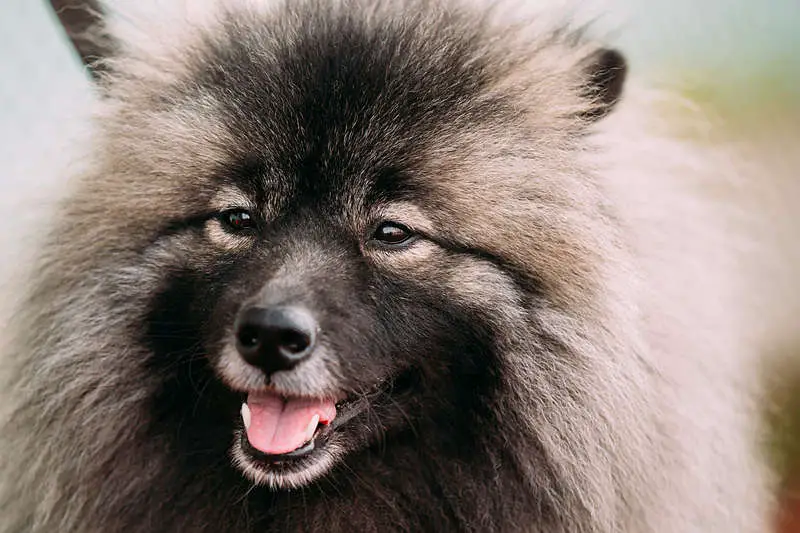Dogs don’t come much handsomer than the royally ruffed Keeshond, a breed that came of age on the barges of Holland, gained significant political and national symbolism, and today is coveted far from its native waterlogged lowlands.
Before we dive into the breed profile, let’s take care of some semantic points: Despite what you may have heard occasionally down at the dog park, the correct pronunciation of Keeshond is “kayz-hawnd,” and the proper plural form is Keeshonden.

The Keeshond dog breed
History
The Keeshond stems from that large and varied group of working dogs the spitz family, characterized by their upcurled tails and often thick, heavy, long-haired coats. The ancestral spitz dogs are thought to have arisen in the Eurasian subarctic, and certainly many of them – the Keeshond included – has the look of a snow-country dog. (Another name for the Keeshond is the Wolfspitz, presumably a reference to its wolfishly silver-gray coat.)
But the Keeshond itself developed in balmier climes as a barge dog of Dutch boatmen on the Rhine and the canals of the Low Countries. (Another alternative early name for the breed was simply the Dutch Barge Dog.)
The Keeshond’s moniker comes from its association with the Dutch Patriots Party, a political group of the late 18th century opposed to the Prince of Orange and his Orangist supporters. The Patriot leader Cornelis de Gyselaer was nicknamed “Kees,” and apparently owned one of these barge dogs that was also named Kees; as a symbol of the Patriot movement, the breed became known as the Keeshond.
The Patriots were ultimately unsuccessful and Keeshond ownership took a definite hit after their defeat; changing barge designs and traditions also saw the dogs less favored on the waterways. But (as Petfinder notes in its breed history) the breed pulled through its lean times and eventually caught wider attention in Europe as a housepet.
International interest in the Keeshond spread in the early 20th century, and the dogs showed up in the U.S. by the 1920s; the American Kennel Club formally recognized the breed in 1930.
Appearance
The Keeshond is a medium-sized spitz that stands some 17 to 18 inches at the withers and weighs between 30 and 45 pounds or so.
The deep-chested Keeshond sports a thick coat that swells to a mane-like ruff around the neck that’s heavier in males. The American Kennel Club calls its bushy tail, curled tightly over the back, “a rich plume.” Perhaps its trademark characteristic are the bold markings around its eyes that give it the appearance of wearing spectacles.
There’s a deep stop separating the top of the head from the relatively short, thick muzzle, and the ears are small and pricked.
The dense coat, which is composed of the coarser, longer topcoat above a soft, thick undercoat, flares on the rump and hind legs to form a “trousered” look back there.
The coat is a soft, attractive gray-washed tone created by black-tipped hairs and varying proportions of a creamy white woven into the silvery mosaic.
Personality and temperament
The ever-smiling Keeshond is a friendly, affectionate, and good-natured dog that tends to bond very tightly with its owners. Smart and easily trained, the Keeshond makes a great companion to children and tends to be amiable toward strangers accepted by its family, though it’s also a good watchdog with a whole lot of bark.
Such is the Keeshond’s friendliness, gentleness, and sociability that it’s commonly employed as a therapy dog.
Shedding and grooming
Keeshonden are seasonal shedders. Weekly brushing will help keep the coat looking plush and healthy, as will occasional bathing. Not much in the way of trimming is required except perhaps around the feet and lower legs.
Health and lifespan
A Keeshond will often live to be 12 or 13 years old, with quite a few dogs reaching the old age of 14 or 15. This is quite a healthy breed with few major chronic problems, although issues such as patellar luxation and hip dysplasia aren’t unheard of. An under-exercised Keeshond can easily become obese, too.
Exercise needs
The Keeshond needs regular exercise and will thrill to come along with you for walks, runs, or all-in play bouts. (These are exceptionally playful dogs.) Given enough romping and patrolling time on a daily basis, it will also very happily kick back and relax with you.
Training & intelligence
Keeshonden on the whole are an absolute joy to train: quick-learning, attentive, and eager to please. It’s true that their braininess means they can be quick to pick up bad behavior learned from other dogs, but generally speaking it’s quite easy to mold your Keeshond into a reliably obedient and extremely agreeable companion. Just keep in mind that these smart and enthusiastic dogs can also become bored quite easily, so be sure to keep the training exercises interesting.
